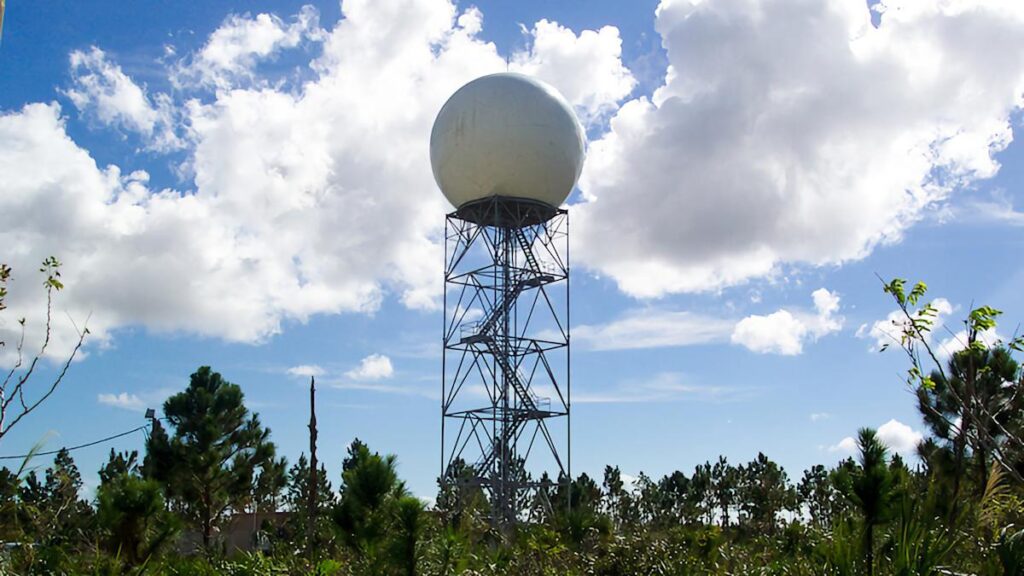
<span class=caption-credit> National Severe Storms Laboratory</span>
NOAA Issues Warning as Militia Group Targets Weather Radars as “Weather Weapons”
A NEXRAD weather radar station operated by the National Weather Service. Credit: National Severe Storms Laboratory
Table of Contents
Militia Group Targeting Weather Radar Stations
The National Oceanic and Atmospheric Administration (NOAA) has issued an urgent warning to National Weather Service (NWS) staff regarding potential attacks on Doppler radar stations from an armed conspiracy group. According to a report by CNN, a militia known as “Veterans on Patrol” is allegedly planning to target government weather radars based on the false belief that these installations are being used as “weather weapons.”
Internal emails obtained by CNN revealed that NOAA officials have warned staff about the group’s intentions to conduct “penetration drills on NEXRAD sites to identify weaknesses.” The ultimate objective of these operations appears to be the destruction of NEXRAD (Next Generation Weather Radar) installations—critical infrastructure used for weather monitoring and public safety across the United States.
Security Alert:
NOAA has advised weather service personnel to implement a buddy system when working at remote radar sites and to report any suspicious activity to law enforcement immediately.
NEXRAD: Purpose and Critical Importance
Despite being characterized as “weather weapons” by the conspiracy group, NEXRAD systems serve a crucial and benign purpose in meteorological monitoring. These sophisticated Doppler radar installations are designed primarily to detect precipitation in the atmosphere, enabling meteorologists to identify and track developing weather patterns, including severe thunderstorms and tornadoes.
The technology plays a vital role in the early warning systems that help protect communities across the United States. When severe weather threatens, NEXRAD systems provide critical data that allows authorities to issue timely evacuation orders and emergency alerts, potentially saving countless lives. The network of approximately 160 NEXRAD sites nationwide forms the backbone of the nation’s weather forecasting capabilities.
| NEXRAD Function | Public Safety Benefit |
|---|---|
| Precipitation detection | Identifies developing storm systems |
| Tornado identification | Enables timely evacuation of vulnerable areas |
| Wind velocity measurement | Helps predict damaging wind events |
| Rainfall estimation | Assists in flood forecasting and water management |
Origins of “Weather Weapons” Conspiracy Theories
The belief that weather radars function as “weapons” appears to be a new direction for Veterans on Patrol, a group previously associated with white nationalism and government conspiracy theories similar to “Pizzagate.” While the specific rationale behind their focus on weather technology remains unclear, concerns about radio wave exposure are common among various conspiracy-oriented groups.

NEXRAD technology visualizes precipitation patterns to help detect severe weather conditions. Credit: NOAA
This targeting of weather infrastructure bears similarities to other technology-focused conspiracy theories that have led to real-world violence. For example, in 2020, cell towers in several countries were vandalized and set on fire due to unfounded claims that 5G technology was somehow spreading COVID-19. The misconceptions about both technologies stem from fundamental misunderstandings about how radio waves function and their actual effects.
Scientific Reality:
NEXRAD systems operate by emitting radio waves that bounce off precipitation particles in the atmosphere. The returned signals are analyzed to determine the location, intensity, and movement of precipitation—the technology has no capability to control or modify weather patterns.
Safety Measures for NOAA Personnel
In response to the potential threat, NOAA has implemented several safety protocols to protect NWS staff who operate and maintain the radar installations. These measures include:
- Implementing a buddy system for personnel working at remote radar sites
- Enhancing security awareness training for all field staff
- Establishing clear reporting protocols for suspicious activity
- Coordinating with local law enforcement agencies for increased patrols near NEXRAD installations
- Limiting non-essential maintenance at isolated sites until the threat level decreases
These precautions reflect the seriousness with which NOAA is treating the potential threat to both its personnel and critical weather monitoring infrastructure. The agency is working closely with federal law enforcement to monitor the situation and ensure the safety of its employees while maintaining essential weather services.
Current Challenges Facing NOAA and NWS
The threat from Veterans on Patrol comes at a particularly challenging time for NOAA and the National Weather Service. Even without the specter of physical violence, both agencies have experienced significant disruption in 2025. According to reports, hundreds of weather forecasters were recently laid off due to budget cuts implemented by the current administration.
These staffing reductions represent just one of many attempts to reduce government services, placing additional strain on an already stressed weather monitoring system. With fewer personnel available to operate and maintain the network of NEXRAD installations, any physical damage to these systems could have an outsized impact on weather forecasting capabilities nationwide.
Critical Infrastructure:
Weather monitoring systems like NEXRAD are classified as critical infrastructure—their disruption could have significant consequences for public safety, especially during severe weather events.
Broader Implications for Weather Monitoring Infrastructure
The targeting of weather radar installations by conspiracy groups raises broader concerns about the security of America’s scientific and public safety infrastructure. Weather monitoring systems represent just one of many technical installations that may become targets for groups motivated by misinformation and conspiracy theories.
This incident highlights the real-world consequences of conspiracy theories and the importance of protecting scientific infrastructure from threat actors. When critical systems like NEXRAD are compromised or damaged, it’s not just government agencies that suffer—communities across the country lose access to vital early warning systems that help protect lives and property during severe weather events.
As NOAA and the National Weather Service navigate these challenges, maintaining the integrity and functionality of weather monitoring systems remains a priority. Despite budget constraints and external threats, these agencies continue to work toward their mission of providing accurate, timely weather information to the American public.
Public Awareness:
Citizens who notice suspicious activity near weather radar installations or other meteorological facilities are encouraged to report it to local law enforcement, as these systems play a crucial role in public safety during severe weather events.
The situation continues to develop, with NOAA and federal law enforcement monitoring potential threats to weather monitoring infrastructure. As agencies work to address these security concerns, the incident serves as a reminder of the critical importance of scientific infrastructure and the ongoing challenges of protecting it in an environment increasingly influenced by misinformation and conspiracy theories.
Published on May 8, 2025





